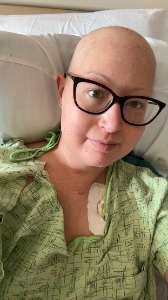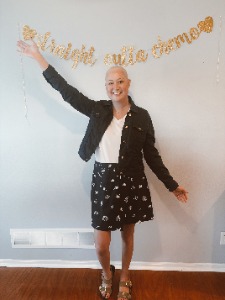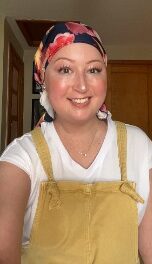Clara spent 8 years post-college living in Colorado Springs, CO, and recently moved back to her home state of Iowa. She enjoys yoga, cycling, and golfing. She is a freelance graphic designer and enjoys cheering on the Iowa State Cyclones!
At just 30 years old, Clara was an avid runner, building her life in Colorado and focused on staying healthy. When back and hip pain from what seemed like a running injury refused to improve, she never imagined that the scans, tests, and emergency room visits that followed would ultimately reveal a lung cancer diagnosis that had already spread to her lymph nodes, liver, bones, pelvis, breast, and brain.
“I was shocked,” Clara recalls. “I’ve never smoked, never vaped, nothing like that. To learn it originated in my lungs was devastating.”
A difficult beginning
 Clara’s road to diagnosis was long and confusing. What began as a herniated disc led to months of pain, bloating, and unexplained anemia. It wasn’t until she took herself to the ER when she was unable to keep down food or fluids that doctors discovered the truth.
Clara’s road to diagnosis was long and confusing. What began as a herniated disc led to months of pain, bloating, and unexplained anemia. It wasn’t until she took herself to the ER when she was unable to keep down food or fluids that doctors discovered the truth.
“They told me, ‘It looks like you have cancer, and it’s spread,’” Clara remembers. “I was transferred to a bigger hospital, prepped for surgery, but then told it was everywhere and that we needed to wait.”
When doctors later confirmed that cancer had reached her brain, Clara was crushed. “Anything neck down I felt like I could handle, but the brain made me think: this is going to kill me.”
Her parents, both already familiar with the cancer world from her mother’s own stage 3 (III) colorectal cancer experience, stepped in. Clara soon relocated to Iowa to be treated by her mom’s trusted oncologist, a move that gave her both comfort and hope.
Treatment challenges
The initial treatment plan was aggressive: 5 rounds of whole brain radiation followed by chemotherapy and immunotherapy. While radiation successfully shrank or eliminated many of the 30+ brain tumors identified on her scans, chemotherapy took a harsh toll.
“Chemo really kicked my butt,” Clara says. After severe reactions during rounds 5 and 6, including losing consciousness and developing sepsis that landed her in the ICU, she understood firsthand why some patients choose to stop treatment. “By the end, I thought: thank God that’s my last one. I don’t think my body could have handled it again.”
Now, Clara receives immunotherapy every 3 weeks. “It’s not terrible. I get sleepy sometimes, but compared to chemo, it’s so much easier. My scans show stability overall, and in my lungs, everything is gone now. I’m happy with the response.”
Redefining stage 4 (IV)
 For Clara, the words stage 4 (IV) initially felt like a death sentence. “I thought, this is it. I’m going to die,” she admits. At one point, she even told her mom, “I just want everyone to get on board with me dying. It’ll make this process easier for us all.”
For Clara, the words stage 4 (IV) initially felt like a death sentence. “I thought, this is it. I’m going to die,” she admits. At one point, she even told her mom, “I just want everyone to get on board with me dying. It’ll make this process easier for us all.”
Encouragement from her oncologist shifted her perspective. “He told me, ‘You’re responding well to treatment. You can live for years to come.’ That gave me hope.”
Clara now works to educate others on what a stage 4 (IV) diagnosis really means. “People hear that I’m done with chemo and assume I’m cured. For many of us, this is a chronic disease. I’ll likely always be in treatment. But the treatment is working for me and I’m hopeful about what could be next if it stops working.”
Community, advocacy, and connection
While treatment has been grueling, Clara has found purpose in sharing her story. Through TikTok and Instagram, she launched Cancer Questions with Clara, connecting with other young patients and offering candid glimpses into her journey.
“I get the sweetest messages and comments,” she says. “Strangers send care packages, donate to my GoFundMe, or just write to say they’re rooting for me. People are so much kinder than I ever imagined.”
Her advocacy has also created unexpected opportunities. Clara partnered with her local LifeServe Blood Center to highlight the importance of blood donation. “Blood transfusions saved my life. To see the bags of blood in their lab that I actually received was amazing,” she shares. She has also participated in podcasts and hopes to lend her voice to national advocacy efforts.
Advice for others
When asked what advice she’d give to another young person newly diagnosed, Clara says:
- Don’t Google everything. “Write down your questions and bring them to your oncologist. I scared myself online.”
- Lean on your people. “You have more love and support than you realize.”
- Accept help. “The best support came from friends who just did things—sending a meal, dropping off a gift card—rather than waiting for me to ask for help.”
Moving forward
 Today, Clara is preparing for surgery to remove pelvic tumors that still cause discomfort. She’s also regaining independence after months of using a walker and a cane.
Today, Clara is preparing for surgery to remove pelvic tumors that still cause discomfort. She’s also regaining independence after months of using a walker and a cane.
“It was tough being 30 years old and pushing a walker into restaurants, but I embraced it. At the farmer’s market, I could load the seat with groceries. It turned out to be useful,” she says with a laugh.
As she continues treatment and advocacy, Clara is determined to help others feel less alone. “I don’t sugarcoat it, it’s hard. But you can get through it. Sharing my story and connecting with others with lung cancer helps because you realize that other people are in the same boat as you.”
Lung cancer in younger adults presents its own challenges, often different from those faced by older patients. With more young people like Clara being diagnosed, even without a smoking history or other common risk factors, this issue is more important than ever. Join us in person or virtually on Tuesday, October 21, for our upcoming Lung Cancer Living Room®, featuring powerful stories from those affected and insights into breakthrough research. young people living with lung cancer.

Leave A Comment